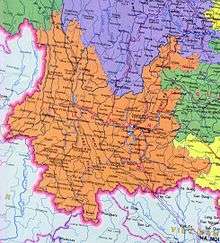Yunnan clique

The Yunnan Clique (Chinese: 滇系; pinyin: Diān Xì) was one of several mutually hostile cliques or factions that split from the Beiyang Government in the Republic of China's warlord era. It was named for Yunnan Province.
Cai E is regarded as the founder of the clique when at the request of Liang Qichao in 1915, he declared Yunnan's opposition to Yuan Shikai's monarchy. Cai died from natural causes shortly after the successful National Protection War. His chief lieutenant, Tang Jiyao, took over Yunnan and demanded that the National Assembly be restored. When this was accomplished, Yunnan officially reunified with the national government but kept its provincial army separate due to the Beiyang Army's grip in Beijing politics.
After the second dissolution of the National Assembly, the Manchu Restoration debacle, and the complete domination of the central government by the Beiyang generals, Yunnan joined several other southern provinces in forming a rival government in Guangzhou during the Constitutional Protection Movement. Tang Jiyao was chosen as one of the seven executives of its ruling committee. Within the committee, there was a power struggle between Sun Yatsen's supporters and the Old Guangxi clique. Tang sided with Sun and helped in the expulsion of the Guangxi executives. In 1921, he was ousted by Gu Pinzhen, whose rule was recognized by Sun. The following year, Gu's army defected back to Tang. Tang sided with Sun again during Chen Jiongming's betrayal. Less than a week after Sun died in 1925, Tang claimed to be his rightful successor and made a move on Guangzhou in a bid to overthrow Hu Hanmin and put himself in charge of the Kuomintang. His forces were routed by Li Zongren during the Yunnan-Guangxi War. Thereafter, Tang joined Chen Jiongming's China Public Interest Party as its vice premier. In 1927, Long Yun seized control of the clique; Tang died shortly after.
Long then re-aligned Yunnan under the Nationalist government in Nanjing but stringently guarded the province's autonomy. Long was a critic of Chiang Kai-shek and after the end of the Second Sino-Japanese War, he was removed from office.